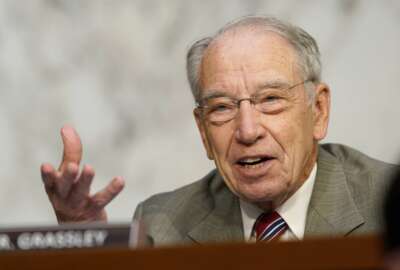Hubbard Radio Washington DC, LLC. All rights reserved. This website is not intended for users located within the European Economic Area.
On Air: Federal News Network
Trending:
OMB gives agencies four months to figure out shared services
The new strategy details several requirements for agencies to meet by Aug. 31. The goal is to reduce the amount of money agencies spend on commodity IT and have...
wfedstaff | April 17, 2015 3:43 pm
The Office of Management and Budget is re-invigorating the Lines of Business initiatives but with a bit of a twist.
OMB issued its Shared Services Strategy Wednesday detailing the steps over the next four months agencies must take to begin chipping away at more than $46 billion in duplicative IT investments. The plan focuses on commodity IT, such as email and storage, and emphasizes both governmentwide and intra-agency shared services.
The LOB initiative, started under the Bush administration, focused solely on governmentwide initiatives, such as human resources and financial management systems.
The end result would give agencies tools to innovate with less money, wrote Steven VanRoekel, the federal chief information officer, in a blog post.
“[The strategy] covers the entire spectrum of IT shared service opportunities throughout the federal government and promotes the use of existing and new strategic sourcing methods where agencies can combine their buying power for similar IT needs and get lower prices and improved service leverage in the process,” VanRoekel wrote.
VanRoekel said the Shared Services Strategy builds upon the TechStat, recently announced PortfolioStat and the administration’s Campaign to Cut Waste initiatives. VanRoekel released a draft strategy in December, asking agency and industry for comments.
“I’m very supportive of having a shared services strategy, but not because I need OMB telling me what I need to do because we’ve been talking internally about shared services for some time to gain efficiencies and administrative savings, but having OMB push in the same direction helps with momentum,” said one agency CIO, who requested anonymity because they didn’t receive permission from their agency to speak to the press. “I don’t think shared services are new to the government, but the one thing that sets the current discussion apart from the previous shared service providers is while they did have IT systems security, and sort of basic back office functions, where the shared services strategy is going now is expanding beyond that. It’s looking at more traditional IT services like data center or cloud or help desk.”
The strategy sets a series of deadlines for agencies:
- By Aug. 31 — Departments must submit an Enterprise Roadmap to OMB that includes the agency’s commodity IT consolidation plan and LOB Service Plan. A part of this roadmap will be a list of IT assets agencywide to include all IT systems and services that support mission, administrative and commodity IT programs, using the Federal Enterprise Architecture Reference Model taxonomies provided in the common approach.
Additionally, agencies have to give OMB a synopsis of the agencywide IT investment portfolio review conducted annually using the process described in the PortfolioStat memo issued in March.
And finally, the LOB managing partners will prepare a “LOB Service Plan” that includes an assessment of each associated IT shared service area and a plan to improve quality and increase uptake in each area by the end of FY 2013. A high-level summary of alternatives is also to be included which incorporates legacy federal IT requirements and agency goals and/or guidance.
- By Dec. 31 — Agencies must complete two OMB-approved IT shared service initiatives in 2012 and report status to OMB.
- By April 1, 2013 and annually afterwards — Agencies must submit an updated Enterprise Roadmap to OMB.
“The Shared-First approach creates new opportunities for industry to provide shared IT services to agencies that are more agile in delivery and more responsive to a wide variety of evolving mission, support and commodity IT requirements,” VanRoekel wrote. “The strategy recognizes the need for agencies to gain proficiency in managing or consuming shared IT services and therefore provides an initial focus on commodity IT consolidation opportunities, as called for in the August 2011 OMB memo to CIOs.”
| Date | Action | Owner |
| March 1, 2012 | Identify two IT areas for migration to a shared service approach by Dec.31, 2012. | Agencies |
| Aug. 31, 2012 | Submit an Enterprise Roadmap to OMB that includes the agency’s Commodity IT Consolidation Plan (IT Asset inventory is optional in 2012) and LOB Service Plan. | Agencies and their managing partners |
| Dec. 31, 2012 | Agencies complete two OMB-approved IT shared service initiatives in 2012 and report status to OMB. | Agencies |
| April 1, 2013 (and annually) | Submit an updated Enterprise Roadmap to OMB | Agencies and their managing partners |
The strategy also stated OMB is working with the Federal CIO Council’s Shared Services Subcommittee to establish and maintain an online IT Services Catalog. OMB said it will launch this catalog in fiscal 2012 and will provide agencies with a list of available services and contract vehicles, as well as contact information for managing partners and suppliers.
New strategy complements LOB initiatives
An OMB spokesperson said in an emailed statement that “this shared services strategy is complimentary but begins at a different starting point. We are starting this strategy with agency-specific implementations of commodity services (like email, mobile contracts, etc.) and will, over time, look for opportunities to take sharing between agencies. This strategy is also an enterprise architecture framework for assessing architectures across these different types of implementations.”
Reaction to the strategy has been fairly positive. Most current and former federal officials say the need to move to shared services has never wavered and adding some more emphasis to it has been a long time coming.
“The intention of the strategy seems to be a focus on flexibility,” said Tim Young, a former deputy administrator for e-government and IT at OMB and now a senior manager for Deloitte Federal Services. “Agencies simultaneously must measure performance and capabilities of the existing LOBs and improve them so more agencies adopt them over time. Additionally, it encourages agencies that don’t use shared services to develop intra-agency shared services to consolidate at a more local level.”
Young said the idea of changing the culture internally to get used to shared services is part of the “crawl, walk, run” approach.
“The current strategy forces agencies to make two moves to eventually insource or outsource IT shared services,” he said. “The first move is intra-agency, and then down the road presumably they will make a decision to consider insourcing those functions to governmentwide shared services provider like DISA or Interior’s National Business Center. Or, they could potentially outsource the services to commercial vendors who provide shared services on broader and more global scale. This approach is softer or a more paced approach to adopt shared services.”
Needs more input from business owners
One senior government official, who requested anonymity because they didn’t obtain permission from their agency to speak to the press, said the missing piece so far is getting the business people, such as the agency deputy secretaries, CFOs and chief acquisition officers involved
“The LOB initiatives were more organized with agency lead,” the official said. “The new effort is more focused on agency decisions and the strategy identifies ways to move in the shared services direction.”
The official added conversations are just starting among the business and IT folks, and that will help push the initiative forward.
Mark Forman, a former OMB e-government and IT administrator and now founder and president of Government Transactions Services, said the goal of the strategy is to drive results, not create another report for agencies to develop.
“One of the things that’s really important for OMB as they finalize this memo is not to lay out as a result you produced a report or piece of paper, but there is some business basis for the type of result they expect the agencies to receive,” Forman said. “It is an improvement in productivity? It is a reduction in expenditures on customizing finance systems and back office systems? There are clear ways to set goals for agencies if you are going to give them the flexibility to figure it out themselves.”
Forman said agencies already have the authority to consolidate internally, and the strategy doesn’t give them enough guidance.
He said the centralized repository of existing shared services will be a key piece to this effort.
“The big gains are not in IT shared services. It’s not a data center that gets consolidated. The big gains are in crushing the redundant, fragmented programs in the areas that have come out in the [Sen. Tom] Coburn (R-Okla.) studies GAO has been doing. I’m really impressed there is recognition of that in these memos.”
RELATED STORIES:
Federal CIO VanRoekel details his ‘first’ priorities
OMB launches PortfolioStat to reduce commodity IT spending
EXCLUSIVE: IT budget guidance muddies OMB’s shared-service plans
Copyright © 2024 Federal News Network. All rights reserved. This website is not intended for users located within the European Economic Area.
Jason Miller
Jason Miller is executive editor of Federal News Network and directs news coverage on the people, policy and programs of the federal government.
Follow @jmillerWFED





